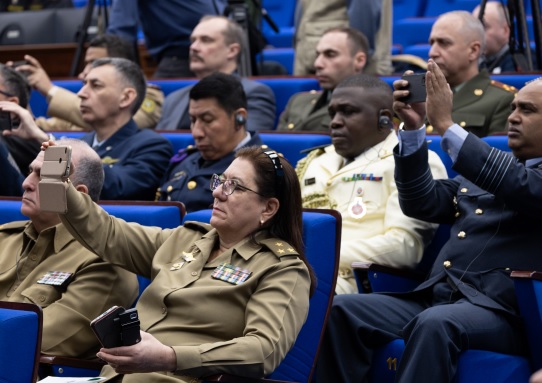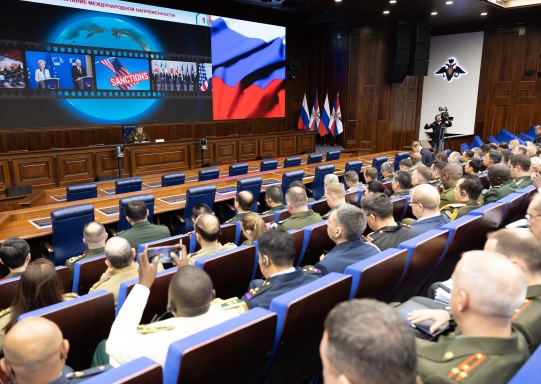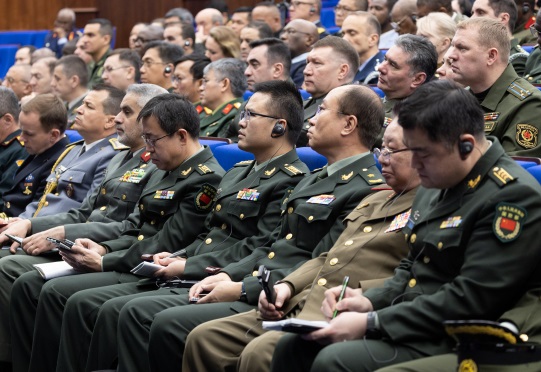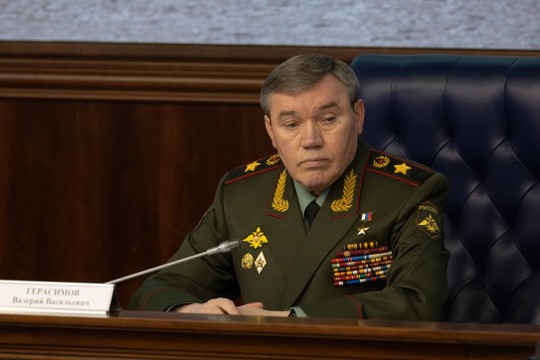Photo: Russian MoD
A briefing by the Chief of the General Staff of the Russian Armed Forces – First Deputy Minister of Defense of the Russian Federation, Army General Valery Gerasimov (photo) was held in Moscow with the participation of foreign military attaches. The briefing was dedicated to the results of the activities of the Ministry of Defense of the Russian Federation in 2023. Valery Gerasimov’s key points:
- At the moment, military and political situation changes rapidly. A new multipolar world is shaping, hegemony of the USA and its allies is left behind in the past.
- The USA and its allies are systematically breaking the rules of international law undermining the role of the UN as a key institute, which harmonises relations between nations.
- Washington willingly broke all core agreements constituting the framework of the armament control system.
- As the West maintains its course towards Russia's strategic defeat, the implementation of confidence-building measures in the field of European security has lost its relevance.
- The European continent has become an arena of confrontation between the West and the Russian Federation in the political and economic spheres. The accelerated integration of Sweden and Finland into the alliance, the increased military presence of NATO troops in Eastern Europe, the Baltic and Black Sea regions, as well as in the Polar Regions, have a negative impact on the situation in Europe with prospects for increased confrontation.
- The intensity of operational and combat training activities conducted by the NATO Allied Forces remains high. Every year, about 40 major exercises are held near Russia's western borders with scenarios based on armed confrontation with our country. Increasingly, the exercises involve states outside the Alliance.
- At the same time, the West seeks to create new hot spots and maintain conflicts in the Balkans, Transnistria and Transcaucasia, Central Asia, and Afghanistan.
- The situation remains dire in the Syrian Arab Republic, where the continuing activity of terrorist groups together with the sanctions pressure of Western countries led by the United States of America are hindering efforts aimed to restore peaceful life.
- Illegal extraction and sale of natural resources led by the U.S. continues in the northeast.
- It should be noted that irresponsible U.S. policy has led to another round of escalation in the Middle East.
- Thus, the long-standing Palestinian-Israeli confrontation has turned into an open armed conflict with numerous civilian casualties on both sides.
- In Transcaucasia, the situation remains tense but has a steady trend towards stabilisation.
- On the political track, the Russian Federation is working purposefully to unblock transport communications in the Transcaucasia, conclude a peace treaty between Baku and Yerevan, and resolve the most acute Armenian-Azerbaijani contradictions.

- The Asia-Pacific region has seen a dramatic increase in conflict potential. Its main reason is the actions of Western countries aimed at undermining the ASEAN-centric multilateral security architecture that has been established here and has proved its effectiveness.
- Thus, the creation of NATO-like military blocs in the Asia-Pacific region, such as AUKUS, the U.S.-Japan-Republic of Korea trilateral alliance and other quasi-alliances military in nature bring challenges and threats to the region similar to those that Europe is faced with today.
- The United States and NATO have focused on ensuring their dominance in the Arctic and deterring the Russian Federation in the region. To this end, the collective West is increasing its military presence in high latitudes and developing military infrastructure near the borders of the Russian Federation. As a result, the potential for conflict in the region is increasing.
- I draw your attention to the fact that the presence of the Armed Forces of the Russian Federation in the Arctic is not related to the demonstration of military force, but to ensuring the security of the economic development of the region, including navigation in the waters of the Northern Sea Route and the implementation of projects in the area of exploration and extraction of natural resources.
- The countries of the collective West ignored Russia's demand for a mutual security agreement and defiantly supported the neo-Nazi regime in Kiev, which unleashed the destruction of the Russian-speaking population of the Donetsk and Lugansk people's republics.
- For eight years, the West has been actively building up the military potential of the Ukrainian armed forces, pushing Kiev towards a resolution of the conflict in Donbass by force and an invasion of the Crimean peninsula.
- Because of that, Russia was forces to begin the special military operation.

- Today, Washington's policy is aimed at prolonging the Ukrainian conflict. To this end, Ukraine is provided with significant military and military-technical assistance.
- Since February 2022, Kiev has received more than 5,200 tanks and armoured fighting vehicles, more than 1,300 field artillery pieces, 200 multiple launch rocket systems, more than 23,000 anti-tank guided missile systems, 1,200 anti-aircraft missile systems and installations, more than 100 aircraft, 23,000 drones, as well as a significant amount of ammunition of various types. About 100,000 Ukrainian servicemen underwent training in the USA and Europe.
- The United Kingdom and France have handed over 200 Storm Shadow and SCALP air-to-ground guided missiles to Kiev, which are used, among other things, to hit civilian targets in Crimea and Donbass.
- In October this year, Washington delivered ATACMS operational-tactical missiles to Ukraine to prolong the agony of the Kiev regime.
- Despite the large-scale military and financial assistance provided to Ukraine by the West and the total mobilisation of Ukrainian citizens, the Armed Forces of the Russian Federation are still effectively carrying out tasks to achieve the objectives of the special military operation defined by the Supreme Commander-in-Chief.
- This year, the main task was to repel the AFU's counteroffensive, whose backbone were brigades trained and equipped by Western countries.
- The AFU, which launched the offensive on 4 June 2023, managed to make some progress in Zaporozhye direction at the cost of heavy losses. The enemy though did not even manage to cross the tactical defence zone of Russian troops.
- There has been no change in the situation on the battlefield as a result of additional supplies of Western weapons to the Kiev regime and the introduction of strategic reserves by the Ukrainian command. The number of casualties among the AFU troops only increased as a result of these actions.
- Thus, the widely publicised counteroffensive by Ukraine and its NATO allies failed.
- For half a year, enemy losses in all directions were about 160,000 troops, over 3,000 armoured fighting vehicles, including 766 tanks, 121 airplanes, and 23 helicopters.
- In order to achieve the objectives of the special military operation, long-range precision weapons are used to hit the control points of the AFU troops, defence enterprises, and critical military infrastructure. In total, about 1,500 targets were hit.
- A significant decrease in manufacturing products of the Ukrainian military industrial enterprises was one of the results of deploying high-precision weapons.
- Seeing that the AFU is incapable of achieving its battlefield goals, the Kiev regime continues to use terror tactics with tacit approval and often with support of Western intelligence agencies.
- Thousands of violations of international humanitarian law have been on record since the beginning of the special military operation.
- Missile and artillery attacks against peaceful cities and settlements in the Russian Federation are conducted every day without any justification of military necessity. As a result, residential areas, hospitals, schools, and other social facilities have been destroyed.
- Ukrainian forces use tactical missiles, large-calibre artillery, mortars, and MLRS, including banned cluster munitions and anti-personnel mines, to attack civilian infrastructure.
- On the territory of the Donetsk People's Republic alone, more than 4,700 (4,755) civilians, including 140 children, have been killed since February 2022. More than 5,000 other people were wounded.
- Ukraine is not giving up its attempts to carry out acts of nuclear terrorism and is systematically sending unmanned aerial vehicles equipped with explosive devices to the Zaporozhye Nuclear Power Plant and the city of Energodar.
- In May, Ukrainian saboteurs attempting to blow up power lines at the Leningrad and Kalinin nuclear power plants were thwarted.

- In the current situation, the Russian Ministry of Defence continues its planned activities to strengthen the country's defence capabilities.
- The Strategic Nuclear Forces continued their planned rearmament with the Yars and Avangard missile systems. They also modernised their long-range aircraft to ensure the deployment of modern long-range precision cruise missiles.
- Another Borei-A nuclear submarine cruiser, the Emperor Alexander III, armed with Bulava ballistic missiles, joined the Navy.
- The proportion of modern weapons in the nuclear triad was increased to 95%.
- Taking into account the experience of the special military operation, the necessary measures have been taken to improve the composition and structure of the Armed Forces and to enhance the capabilities of the general-purpose forces.
- Two strategic territorial formations of the Armed Forces – the Moscow and Leningrad military districts – are created in response to NATO expansion.
- According to the decision of the Supreme Commander-in-Chief of the Armed Forces of the Russian Federation, the gradual increase of the composition and size of the Armed Forces was continued, and their full-time strength was increased to 1,320,000 troops.
- Two combined-arms armies and fourteen formations have been formed in the Land Forces.
- In order to build up the capabilities of the Russian Federation's aerospace defence system, three formations of the Russian Aerospace Forces have been established.
- The Navy has received four submarines and eight surface ships of various classes. To fulfil missions in oceanic and maritime regions, modern warships are being built.
- The country's defence industry complex is multiplying its capabilities, providing the aviation, navy, and land forces with a full range of armament, missiles, and ammunition.
- This year, more than 1,500 new and modernised tanks and some 3,000 armoured fighting vehicles have been delivered to equip the troops. Over 230 aircraft, over 80 types of ground-to-air weapons, and over 20,000 drones of various classes and types were delivered to the troops.
- This year, the Armed Forces intensified operational and combat training with foreign partners. In total, 17 international exercises were organised and attended.
- The annual ARMY Military and Technical Forum was attended this year by delegations from the defence ministries of 83 foreign states, including 41 delegations headed by defence ministers and their deputies.
- Around 200 bilateral meetings have been held with partners in other countries. More than 28,000 samples of military and dual-use products were exhibited by almost 1,500 domestic and foreign companies and organisations.
- The 11th Moscow Conference on International Security took place in August. The event was attended by more than 800 delegates from 76 countries and 6 international organisations.
- The conference discussed issues of global security in a multipolar world. It also looked at the interaction of military agencies in modern conditions.
- In order to ensure the peaceful socio-economic development of Russia, next year we will continue to work on creating conditions for stabilising the situation at the global and regional levels, as well as on the progressive and balanced development of the Armed Forces.
read more in our Telegram-channel https://t.me/The_International_Affairs

 10:07 22.12.2023 •
10:07 22.12.2023 •























